
Gaiety of Spirit: The Sherpa People of the Khumbu, Nepal
Part 3: The Wheel of Life
Sherpa religious and cultural rituals are generally unchanged for the important events of life: birth, marriage and death
The “inside culture” of the Sherpas – how they mark life’s and the year’s important passages – remain relatively unchanged despite the obvious changes to “outside” aspects such as houses, clothes, and educational and economic opportunities.
Many households and communities will schedule important activities whether travel, rituals, weddings, and funeral rites on auspicious days of the week, lunar month, and year.
The genealogy of the Sherpa follows clans that descend through one’s father. Tradition stipulates that one cannot marry within one’s own clan. Marriage with someone from one’s mother’s clan is permissible, if the couple is not related within three generations. Sherpas still strictly adhere to these proscriptions.
Sherpa Weddings
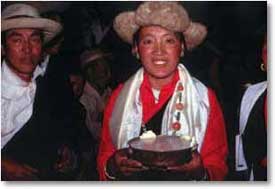 Wedding traditions are still followed very strictly in Khumbu and with minor modifications among Sherpas living in Kathmandu or even abroad. There are several stages to a Sherpa wedding. Sodene is the asking or the engagement. Demchang is the establishment of a proper agreement. Trichang sets the year and month of the final ceremony; Pechang is the consultation that sets the actual date. Zendi is the final ceremony where the woman comes to live with the man. The bride’s family gives presents and property that is her inheritance from them.
Wedding traditions are still followed very strictly in Khumbu and with minor modifications among Sherpas living in Kathmandu or even abroad. There are several stages to a Sherpa wedding. Sodene is the asking or the engagement. Demchang is the establishment of a proper agreement. Trichang sets the year and month of the final ceremony; Pechang is the consultation that sets the actual date. Zendi is the final ceremony where the woman comes to live with the man. The bride’s family gives presents and property that is her inheritance from them.
Sherpa Funerals
The Sherpa funeral rituals are strictly adhered to whether the deceased resided in Khumbu or Kathmandu. 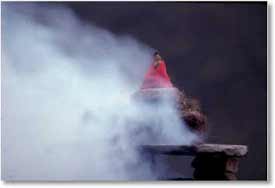 When a person dies, lamas are called immediately to perform rituals to try to generate good, positive energy for the deceased. There are many different customs, but, usually, the body is kept for three days then cremated. The remnants of the fire mixed with clay and are made into tsatsa that are left in a chorten or under a large rock at the end of 49 days.
When a person dies, lamas are called immediately to perform rituals to try to generate good, positive energy for the deceased. There are many different customs, but, usually, the body is kept for three days then cremated. The remnants of the fire mixed with clay and are made into tsatsa that are left in a chorten or under a large rock at the end of 49 days.
Every seven days after the death, special prayers are offered in the home of the deceased. Within three or four weeks, the prayers called Shitro are done for three to fifteen days, depending on the finances of the family. Every evening the family places an offering of tsampa on the fire’s hot coals for the spirit of the deceased. The Bar-do for 49 days after the death is the time and space between lives, by the end of which the person’s next life is determined and they may be reborn.
Special rituals are performed for high lamas and rinpoches, and the body is cremated in a special chamber.
These photographs are of the cremation of Dhui Rinpoche, a very important teacher who passed away in 1989 at the age of 86. On the day of his cremation, his body was carried up the mountainside to a prominent ridge.
His funeral was a celebration of an accomplished lifetime. Over seven hundred people came from as far away as six days walk. His body was placed in the stone monument to be cremated as an offering.
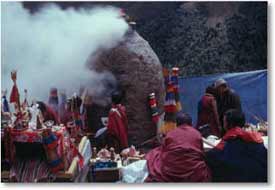
Changes in Sherpa Livelihoods
From Trading across the Himalaya to Global Tourism
As a people, the Sherpas have historically responded and adapted to changes brought by the outside world. In the mid-1800s, the Nepali government granted the Sherpas a trade monopoly by prohibiting anyone but a Khumbu Sherpa from crossing the Nangpa La, the 19,000 ft pass into Tibet. Many Sherpa families benefited to some degree from the bartering that took place in either Tibet or the border towns of India.
Namche was been the main trading centre since 1905. Prior to that, it was simply a place where traders from Khumjung stored their trading goods between the seasons when they could cross the pass to Tibet and when they could travel to the lowlands. The trade to Tibet was drastically reduced after it was taken over by the People’s Republic of China in the late 1950s.
At present a few Tibetan and Sherpa traders cross the pass in both directions. They can be seen at the weekly market along with lowland Nepali traders. The weekly market is not a Sherpa tradition; it was started in the mid-1960s by an army officer stationed in Namche to meet the needs of the growing population of Nepali civil servants.
Outer Changes and Inner Stability
The coming of tourists to the Khumbu Valley has brought outside changes and opportunitie
Since the Nepali government first allowed westerners to visit the kingdom in the 1950s, the coming of tourists from around the world to see the highest mountain has brought a variety of changes both enhancing the livelihoods of the Sherpa people and affecting other cultural and natural aspects of Khumbu.
Tourism has grown to be the main source of livelihood for the Sherpas. Within twelve years from 1983 to 1995, the number of trekkers coming each year grew from 4,000 to 15,000. The number of hotels in Namche grew from 5 to 25. It was only since 1995, that families started constructing buildings to be used as hotels on the north facing area of the village.
Certain families and communities have had opportunities for education, loans, travel, and prosperity. Others struggle with the inflation created by the growing demand for food brought by the annual increase in tourists. Yet, the tourism economy of Khumbu sustains households as far away as ten-days-walk to the south east.
In Sherpa agriculture, potatoes are still dug by hand, and the traditional rules still regulate the annual herding of yaks. Benefits include the places where the national park plantations have transformed bare hillsides to small forests.
Changes in the Khumbu Valley include the bridges and trails. Infrastructure growth has occurred in villages along major trekking routes with changes in traditional building materials. The Lukla airstrip was built in 1964 to facilitate the construction of the hospital in Khunde by the Himalayan Trust. In 2000, over 16,000 passengers flew in or out of Lukla, and hotels and services have been developed to serve them.
While contact with outsiders has brought modern amenities, the Abbot of Tengboche monastery considers the changes in Khumbu:
“There are outward changes in our dress, houses, occupations and opportunities. However, contact with westerners has not necessarily changed the Sherpa culture in terms of ‘inside’ culture – in what they believe and celebrate. Sherpas, young and old, all do pujahs for naming children, weddings and funerals. We celebrate Dumje, the Sherpa new year, and other festivals. What is most important to us remains.”
Sherpa Village Life
Surviving in these mountain settlements requires community effort
Community norms and rules traditionally regulated everything from the collection of fuel wood and leaf-litter, to the movement of the yak herds, to the performance of cultural rituals and festivals. Members of the community are still elected to three positions that manage agriculture and grazing, forest use, and cultural life. They have the authority to impose fines on villagers who break the traditional rules, called the “dhi.”>
Dumje Festival – A celebration of community spirit
The Sherpa year revolves around the main festival of Dumje celebrated in each village at the beginning of the monsoon in late June or early July. 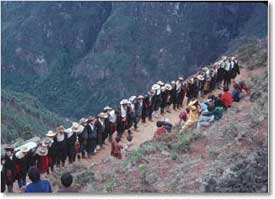 Dumje began as a way to unite the newly settled villages after the Sherpas arrived in Khumbu.
Dumje began as a way to unite the newly settled villages after the Sherpas arrived in Khumbu.
Each year, eight households in a village have a turn, which comes about every sixteen years, to sponsor the festival. Each sponsor provides food for the festivities according to their means. Though this huge financial obligation may cause less affluent families to borrow substantial sums of money from lenders, most families see Dumje sponsorship as a worthy community involvement.
While in the past men from the village who had some religious training would prepare for the rituals, now the village invites and hires specialists, monks from the monastery to come and help prepare for the celebration. Also whereas in the old days, the most learned of the lay lamas (ministers) would officiate and lead the prayers, now the heads of the local monasteries would come to a village.
“We pray together, we dance together and we eat together. What is important now, at Dumje, is that we are all here cooperating together”
The men of the village gather for prayers to Khumbila start the festival. They put up new prayer flags, share chang (rice beer), do traditional Sherpa line dances, and throw tsampa (barley flour) for good luck.
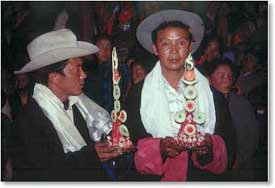
The cowboy hats were adopted as fashionable wear by Tibetans and Sherpas after members of a 1905 British expedition to Tibet wore Stetsons.)

